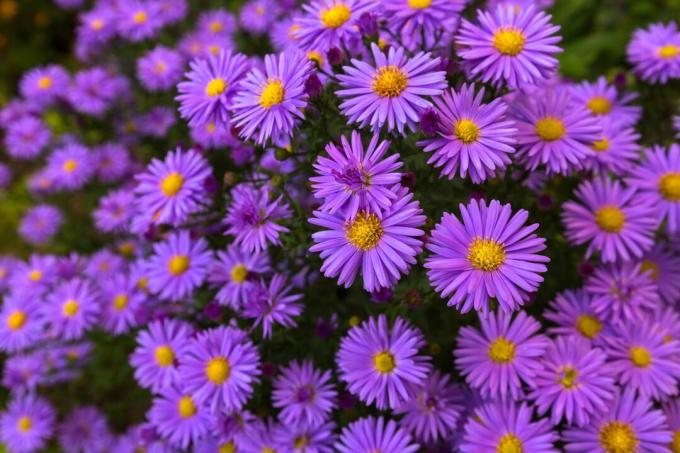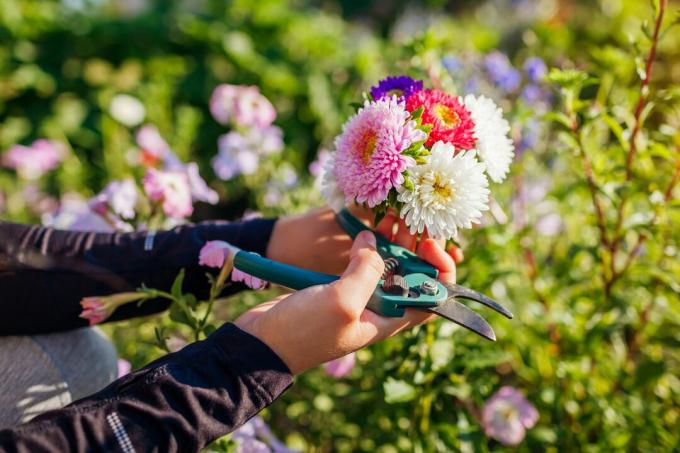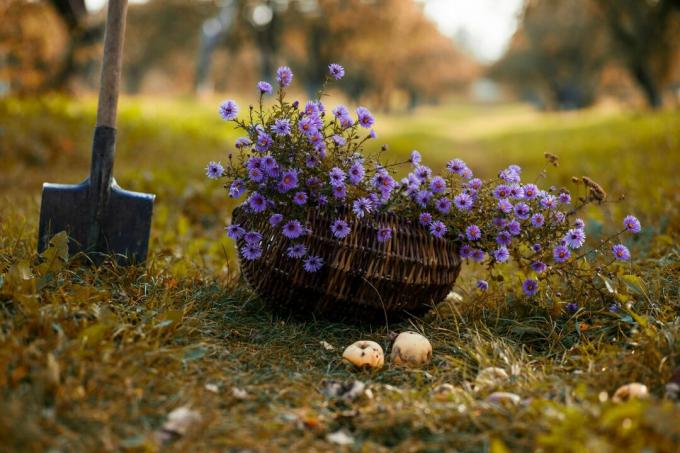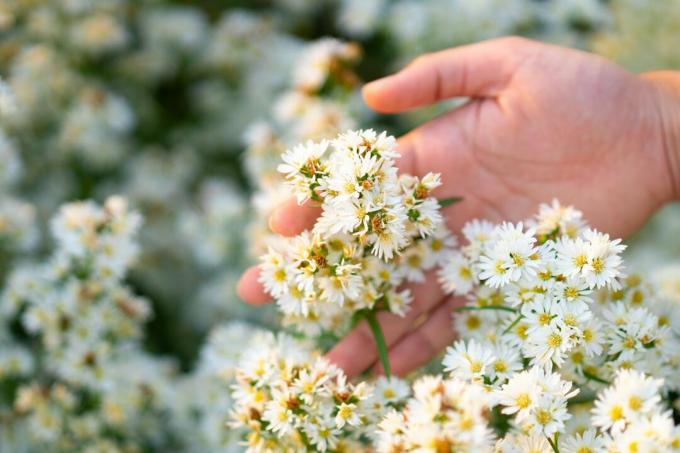Asters look great in any garden or park. Anyone who plants the beautiful flowers in the garden can marvel at their blossoms from May to November.

The late-flowering smooth-leaf aster (Symphyotrichum novibelgii), the flat growing cushion aster (Aster dumosus) or the colorful borage aster (Symphyotrichum novae-angliae) have been delighting us in gardens with their blooms for years. The care of the aster is also not very complicated, which is why its triumphant advance in perennial use is hardly surprising. You can learn more about how to care for this superb group of garden perennials in this article.
contents
- Asters: origin and properties
- Planting asters: location, planting time and more
-
The right care
- watering and fertilizing
- cut asters
- pests and diseases
- Which asters are hardy?
- propagation
- Are asters poisonous?
Asters: origin and properties
Asters belong to the daisy family (Asteraceae), which gave the plant genus its name. The plants, also known as star flowers, originally come from America, Africa, but also Eurasia.
Tip: After a reorganization of the botanical system within the daisy family, species such as the smooth-leaf aster and borage aster no longer belong to the genus aster, but are still called asters colloquially. There are also many other daisies, which are also referred to as such because of their great similarity to asters. You can read more about this in the article on aster species and varieties.
Since the herbaceous plants have a great diversity of species, the spectrum of appearance is also very broad. The growth height can vary from a few centimeters to 3 meters. The leaves of the asters can be basal or alternate, petiolate or sessile on the stem. But the structure of the flowers is quite uniform in all aster species and varieties. The cup-shaped flowers consist of a ring of white, pink, violet or blue colored ray florets with yellow tubular florets in the center.

How long do asters bloom? Aster flowering times also vary by species or cultivar.
- Spring Asters: flowering time in May
- Summer asters: Flowering time from July to August
- Autumn Asters: Flowering period September - October
- Winter Asters: Flowering October - November
The group of asters is particularly valuable for bees due to the wide range of flowering times that can result from planting different aster species. The late-flowering asters in particular are an important source of food for the insects when there are hardly any other flowers left.
Are asters annual or perennial? The majority of asters are perennial. The annual summer asters (Callistephus chinensis) are actually annuals, but actually do not belong to the genus aster.

Planting asters: location, planting time and more
The location of the aster should be sunny and have loose, well-drained soil with a medium nutrient content. But there are also species that tolerate penumbra well.
The best time to plant an aster is from March to May or from September to November. When planting, it is important not to put the perennial deeper into the ground than it was in the pot. Small species such as the cushion aster can be planted about 25 cm apart, medium-sized species 45 cm apart and large specimens 50 to 60 cm apart.
sowing: From mid-May it can be sown broadly in a good location outdoors and after germination it can be scattered to the species-specific distance. When pre-cultivating indoors, the seeds can be placed 1 cm deep in seed soil from February. The substrate should then be kept moist and a germination temperature of around 15 °C should be ensured. It can take more than four months before the plants are strong enough to be planted outdoors.
If the asters are cultivated in pots, which is only suitable for a few species such as the small borage aster, regular water and nutrient supply should be considered. Use well-drained, structurally stable soil. Our Plantura organic potting soil For example, it is particularly suitable for planting due to the long-term fertilization it contains, since asters are sensitive to excessive nutrient concentrations. The broken expanded clay in the soil also ensures high structural stability.
The right care
The care measures for asters include pruning in March outdoors and in pot culture, occasional fertilization and moderate watering.

watering and fertilizing
Asters in pots should be fertilized about every two weeks from April to August. It is advisable to use an organo-mineral fertilizer to cover the perennials' nutrient requirements. For example, our Plantura organic flower fertilizer can be used, which is mixed in when potting and practically only has to be used once or twice a year. This long-term fertilizer can also be used in spring for asters outdoors.
The plants should be well supplied with water, especially during the development of the flowers, as the flowers can otherwise be rather sparse. If the drought lasts for a long time, your garden asters should be watered outdoors regularly. The substrate in the pots should be kept moderately moist and should neither dry out nor become waterlogged.
Faded buds can be constantly trimmed to encourage further bud growth. Dividing the plant every two to three years is also recommended to keep the asters vital. This works best with the individually growing plants that can also be cultivated in a pot, such as the cushion aster. When dividing the perennial in the case of pot culture, the old substrate can also be replaced with a new one.

cut asters
Apart from the regular trimming during the flowering period, towards the end of the winter period, approx in March, the asters are cut back close to the ground, which encourages new growth of the plants encourages. The withered parts of the plant offer protection over the winter. To prevent self-seeding, the upper third can be shortened after flowering.
Are hardy asters pruned? Even hardy asters should only be cut back in spring to protect the root ball from low temperatures.

pests and diseases
The most common diseases are aster wilt and powdery mildew. Aster wilt is indicated by brownish discoloration of the foliage and sagging leaves. This should be avoided from the outset by purchasing resistant varieties. You can find out about recommended varieties, for example, on the website of the Perennial Viewing Working Group or in the course of a consultation at the perennial nursery. A mildew infestation can also be kept within limits by robust varieties, but unfortunately not always. Sprinkle with a Field horsetail brew can also help here. More about the powdery mildew and downy mildew and how to combat it you can read in our article.

Which asters are hardy?
With the exception of the one-year-old summer asters, all asters are hardy. In order to offer them additional protection, the ground outdoors can be covered with leaves, brushwood or fir branches. The asters in pot culture should definitely be placed on a protected house wall and the pot wrapped with fleece to protect the root ball. It is important not to forget to moisten the soil occasionally, otherwise the plants will die from drying out.
propagation
The perennial asters are easy to propagate by division, which should be done every few years in spring or autumn anyway, provided the type of planting allows it. The root suckers of the mother plant can be dug out of the ground with a spade and divided as required. These are then replanted in a new sunny location. Another, but rather difficult, method of propagating perennial asters is via basal shoot cuttings.
Annual asters, such as the summer aster, can be propagated from seeds. After the seeds have bloomed and ripened, they can be harvested and either grown on the windowsill in spring or sown outdoors from mid-May.

Are asters poisonous?
The flowers of the well-known garden asters are edible, i.e. non-toxic to humans, and they also pose no danger to animals. However, since the diversity of species and varieties of asters is so great and they could perhaps also be confused with chrysanthemums, which are poisonous, you should really only consider consumption if you can identify the genus and species with certainty and rule out intolerance can.

If you want to offer the insects in your garden even more food sources in the fall or if you want to benefit from a splendor of flowers yourself, then it is worth adding more autumn flowers to plant. In our article we present the ten most beautiful ones for your garden.


